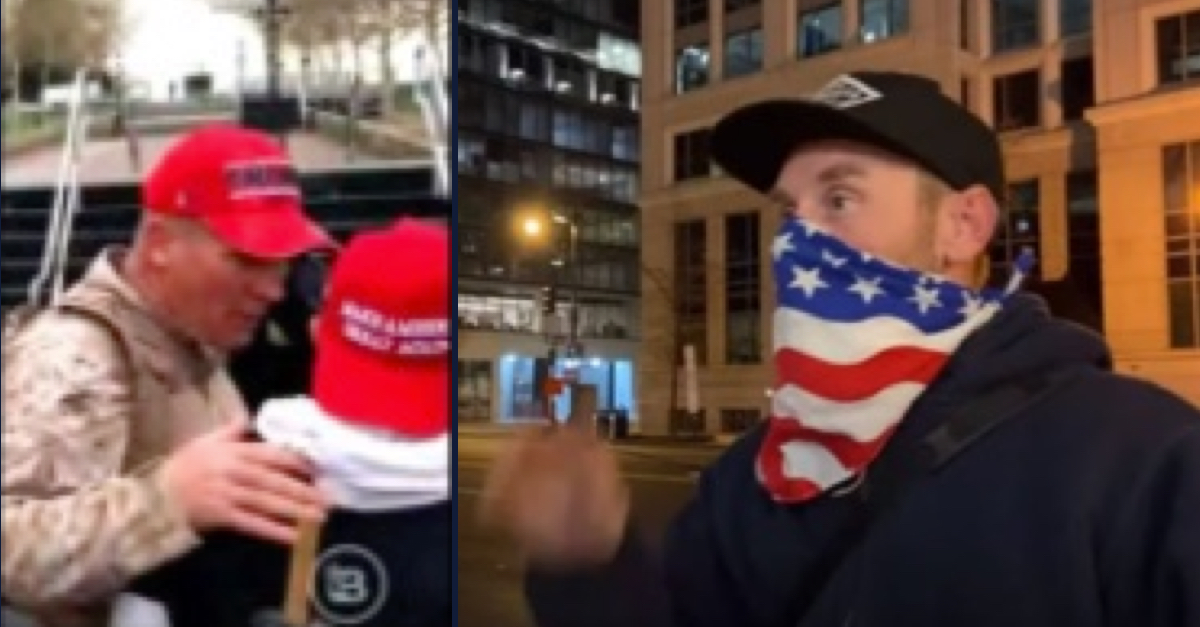
James Ray Epps (L) and Paul Russell Johnson (R) (images via FBI)
One of the men accused of assaulting police officers at the area of the U.S. Capitol known as the Peace Circle says that a man at the center of a disproven Jan. 6-related conspiracy theory is a key part of his defense.
Paul Russell Johnson is one of several defendants who allegedly knocked over a police barricade outside the Capitol on Jan. 6, causing one officer to suffer a concussion.
“It’s our house,” Johnson allegedly shouted at police through a megaphone as a growing crowd gathered at the Peace Circle. “We pay your bills. We pay for this … that’s some bullshit.”
Johnson, along with co-defendants Ryan Samsel, James Tate Grant, Stephen Chase Randolph, and Jason Benjamin Blythe, are accused of working together to overturn a police barricade by pulling and pushing it back and forth. The rocking eventually knocked an officer to the stairs, causing her to hit her head. According to prosecutors, that officer blacked out and collapsed; she was taken to the emergency room where she was diagnosed with having suffered a concussion.
The confrontation occurred at around 12:50 p.m., as the crowd of Donald Trump supporters at the Capitol grew increasingly violent. Within hours, the mob had pushed past law enforcement and breached the building, temporarily stopping Congress from certifying Joe Biden‘s win in the 2020 presidential election.
Photos and videos of the assault at the Peace Circle appear to show Arizona man James Ray Epps at the front of the crowd at the time. Conspiracy theorists falsely painted Epps as an undercover FBI operative. He isn’t one.
The misinformation campaign surrounding Epps began with the fringe-right website Revolver. Fox News talking head Tucker Carlson later amplified that story, which was later blared by leading figures of the pro-Trump political right: including Sen. Ted Cruz (R-Tex.), Rep. Thomas Massie (R-Ky.), and Trump himself.
Epps, the theory goes, was planted by the FBI to rile up the pro-Trump crowd on Jan. 5 and Jan. 6.
“Tomorrow, we need to go in to the Capitol! Into the Capitol” Epps appears to say on a video allegedly taken on Jan. 5.
“Peacefully,” he adds after some in the surrounding crowd appear not to agree.
In response, the right-wing media personality known as “Baked Alaska“—real name Tim Gionet—starts leading the crowd in a chant: “Fed! Fed! Fed!”
In video taken on Jan. 6, Epps is seen yelling into a crowd: “OK, folks, spread the word! As soon as the president is done speaking, we go to the Capitol. The Capitol is this direction.”
Cruz later said people were “understandably very concerned” about the fact that Epps wasn’t arrested or charged in connection with Jan. 6, and wanted an explanation as to why “a person videoed urging people to go to the Capitol, a person whose conduct was so suspect the crowd believed he was a fed, would magically disappear from the list of the people the FBI was looking at.”
Trump made similar statements at a rally later that month.
“How about the one guy, ‘Go in, go in, get in there, everybody,’ Epps. ‘Get in there, go, go.’ Nothing happens to him. What happened with him? Nothing happened,” he said in Arizona on Jan. 15.
However, according to multiple fact checks, Epps is a staunch Trump supporter. He has links to the right-wing Oath Keepers militia group, and was listed as the president of the Arizona chapter in 2011. He has been pictured with Oath Keepers leader Stewart Rhodes, who has been charged with seditious conspiracy in connection with the Jan. 6 attack.
In January, the House committee investigating the Jan. 6 attacks said in a tweet that it had interviewed Epps.
“The Select Committee is aware of unsupported claims that Ray Epps was an FBI informant based on the fact that he was on the FBI Wanted list and then was removed from that list without being charged,” the tweet said. “The Committee has interviewed Epps. Epps informed us that he was not employed by, working with, or acting at the direction of any law enforcement agency on Jan 5th or 6th or at any other time.”
But while Epps was apparently not an FBI plant, Johnson’s attorney Kobie Flowers believes he is crucial to his client’s case.
“Our argument is that James Ray Epps was involved in the attack on the Capitol in a way that would be beneficial to our defense,” Flowers said at a status conference before U.S. District Judge Jia Cobb on Tuesday. He did not elaborate on what those reasons could be, and did not immediately respond to Law&Crime’s request for clarification.
Flowers told Cobb that he was waiting for prosecutors to provide him with more discovery and information Epps.
In many Jan. 6 cases, especially those with multiple defendants, discovery—the exchange of information between the parties to a case—is a sometimes painfully slow process. As the government’s sprawling prosecution of those accused of attacking the Capitol continues into its second year, government lawyers insist that they are making their best efforts to share discovery with defense attorneys, but with the DOJ recently confirming its addition of 131 new attorneys to work on the Capitol breach cases, it is impossible to know when discovery will end.
“New people may get arrested, new things may be acquired,” Assistant U.S. Attorney Karen Rochlin said at Tuesday’s hearing. “Some of those things may be relevant to this case, and when the prosecution team becomes aware of that, we will make every human effort to disclose that data or information forthwith.”
Although Cobb, a Biden appointee, had hoped to set the case for trial, the lawyers couldn’t agree on a date at this time. Cobb set a status conference for May 3.
[Images via FBI.]